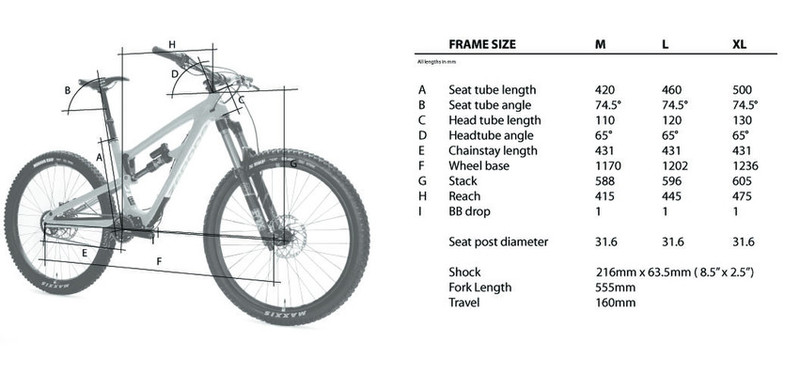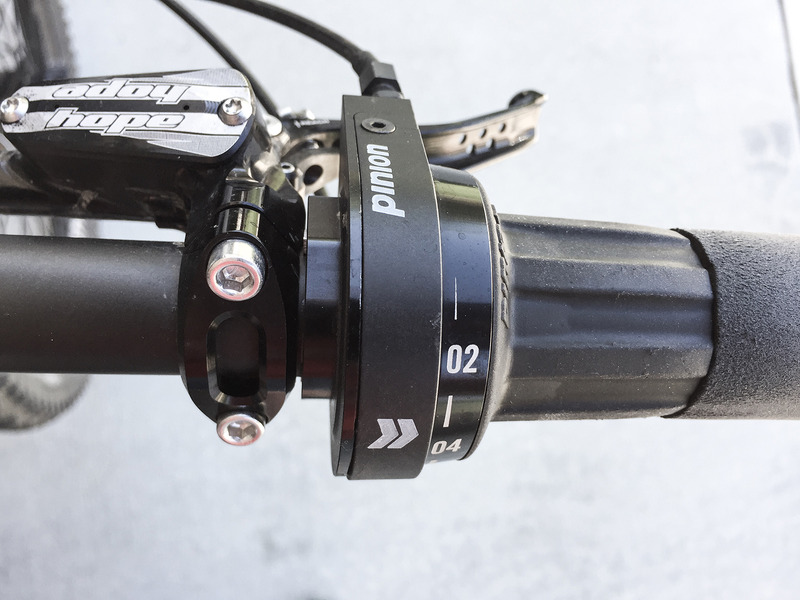Zerode Taniwha Review
 Sunday, May 21, 2017 at 10:17AM
Sunday, May 21, 2017 at 10:17AM  Permalink
Permalink 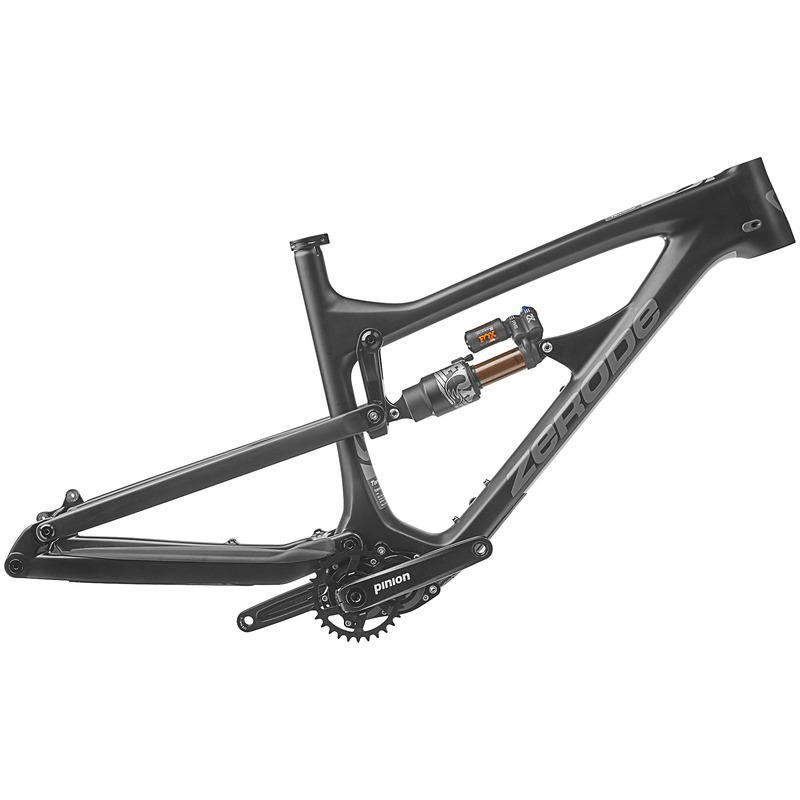 Zerode Taniwha Drive Side Frame
Zerode Taniwha Drive Side Frame
Zerode bikes launched in 2011 and have been producing gearbox Downhill Bikes for 5 years now. During that time there has been a rising demand from customers and others interested in dropping the traditional derailleur on their AM/Enduro bikes. These systems inhibit the suspension, add weight to the rear end and allow a somewhat vulnerable mechanical piece to dangle a few inches from the ground. We would like to introduce you to The Taniwha a 12spd Pinion Gearbox, Carbon Fiber trail slayer.
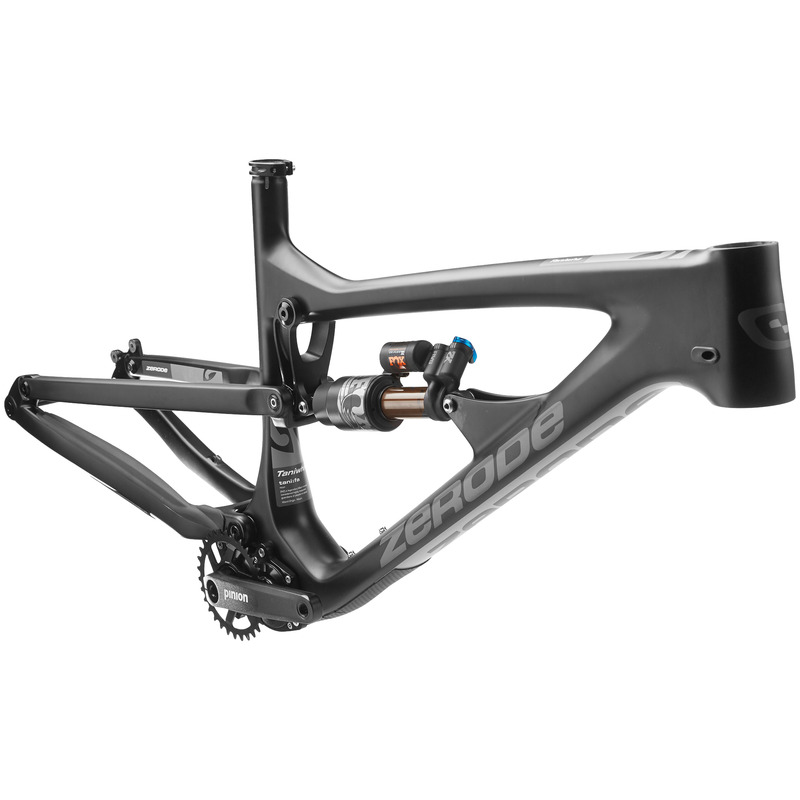 Zerode Taniwha Drive Side Angle Shot
Zerode Taniwha Drive Side Angle Shot
Rob Metz has spent the last 5 years producing Zerode downhill bikes. This was a high single pivot gearbox bike. Well, the time has come for Zerode to release the highly anticipated trail bike. Please allow us to introduce to you The Zerode Taniwha. This is a 160mm, 650b wheeled bike sporting a 65 degree HA and using a Pinion 12 spd gearbox that is mounted into its Carbon Fiber frame! For the “enduro” frame Rob found it best to go with the more common lower single pivot design. Once again you will not need a derailleur, cassette, shifter, chain guide, cranks or BB for the bike.
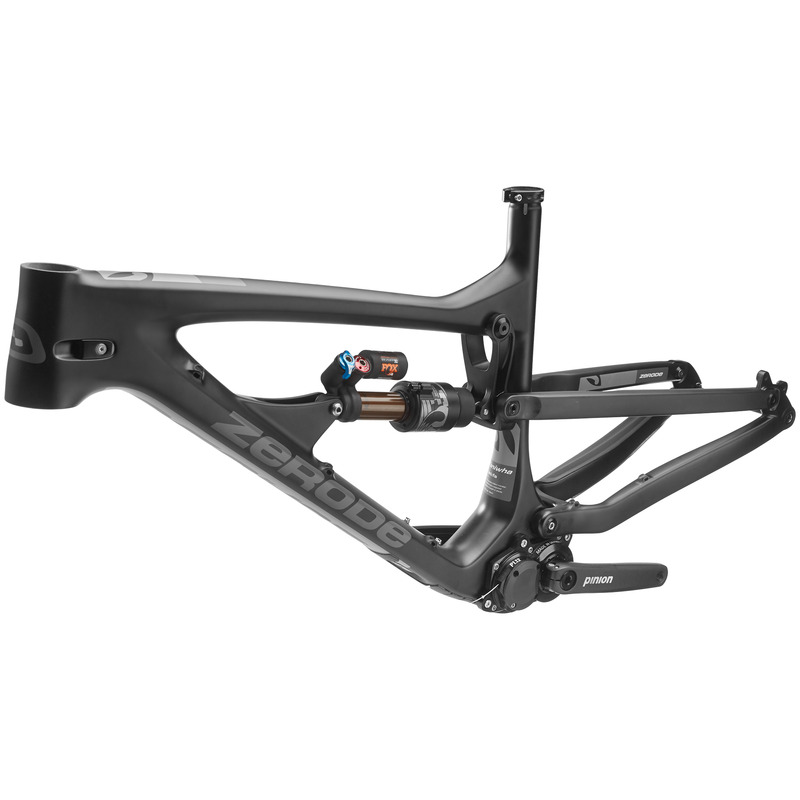 Zerode Taniwha Non Drive Side Angle
Zerode Taniwha Non Drive Side Angle
Zerodeusa began importing and distributing Zerode bikes back in 2011. At that point it was Zerode's high pivot idler bike called the G1. The Mountain Bike market began to change around this time and many people began to trade out their downhill bikes in favor of long travel trail bikes. Once this Enduro craze hit Zerode knew that a trail bike would have to happen sooner rather than later. Rob started contacting carbon manufacturers in Asia about producing small batch runs of the Zerode trail bike. Santa Cruz agreed to help Rob out and sample frames began production shortly after. Take a look at the Geometry of the Zerode Taniwha compared to the Santa Cruz Nomad and you will notice they are nearly identical in the size department.
Zerode Taniwha Features
- Carbon Frame
- 650b
- 12spd Pinion Gearbox
- 31.6 Seatpost
- 142mmx12mm rear hub
- Water Bottle Mount
- 430mm CS Length
- 74.5 Seatpost Angle
- 65 Degree HA
- 600% Range
- Equal Gear Steps
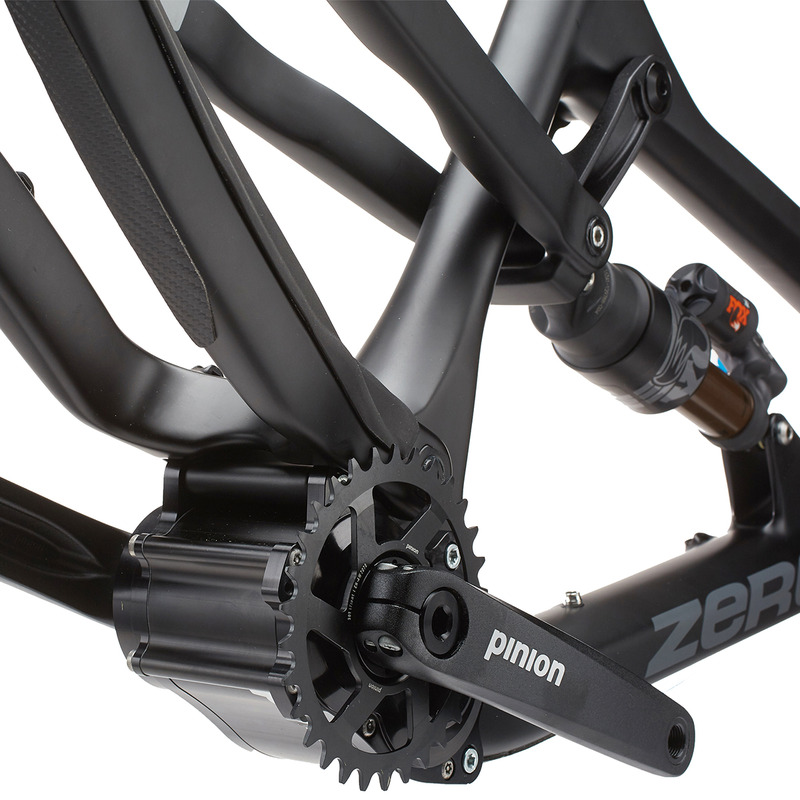 Zerode Taniwha Pinion Drive Side Detail
Zerode Taniwha Pinion Drive Side Detail
The suspension design of the Taniwha is a simple linkage driven single pivot. Rob explains the reason for this is that it has the exact same Anti-Squat (100%) throughout the whole range of travel. This also allows for a very easy suspension set up. The Zerode has a slightly progressive design that the rider can fine tune easily with HSC/LSC and shock spacers. After riding the bike for almost 6 months we can say with certainty that the pedaling feel of the bike is totally unique. It offers tons of traction and never stiffens up while going over obstacles.
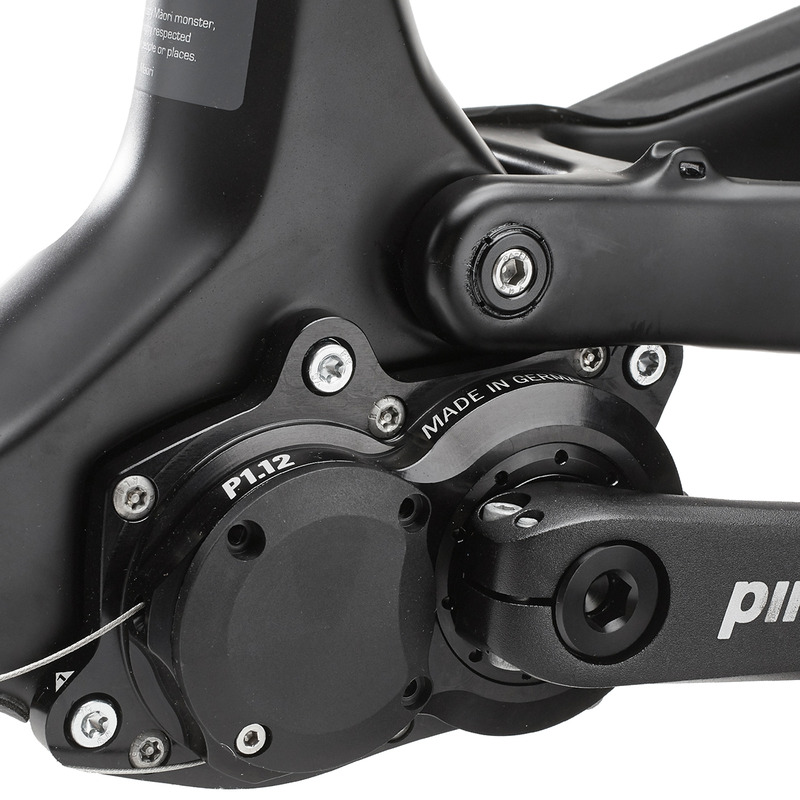 Zerode Taniwha Pinion Non Drive Side Detail
Zerode Taniwha Pinion Non Drive Side Detail
Many gearbox advocates like to press the point that you eliminate the most fragile part of the Mountain Bike when using a gearbox. This is very true to a point but not the reason Rob Metz made Zerode. His driving reason for going the gearbox route was to eliminate unsprung weight from the drivetrain and by doing so dramatically improve suspension performance. The combination of saving 1.5 pounds off your back wheel and keeping chain driven suspension effects away provides a bike that has some of the best feeling suspension that we have ever ridden. It is very sensitive to small nuances on the trail. It feels as supple as a downhill bike going along chatter filled terrain. Having the ability to shift while coasting is another benefit of using a gearbox system. This can allow riders to change gears over the roughest terrain or while in mid turn.
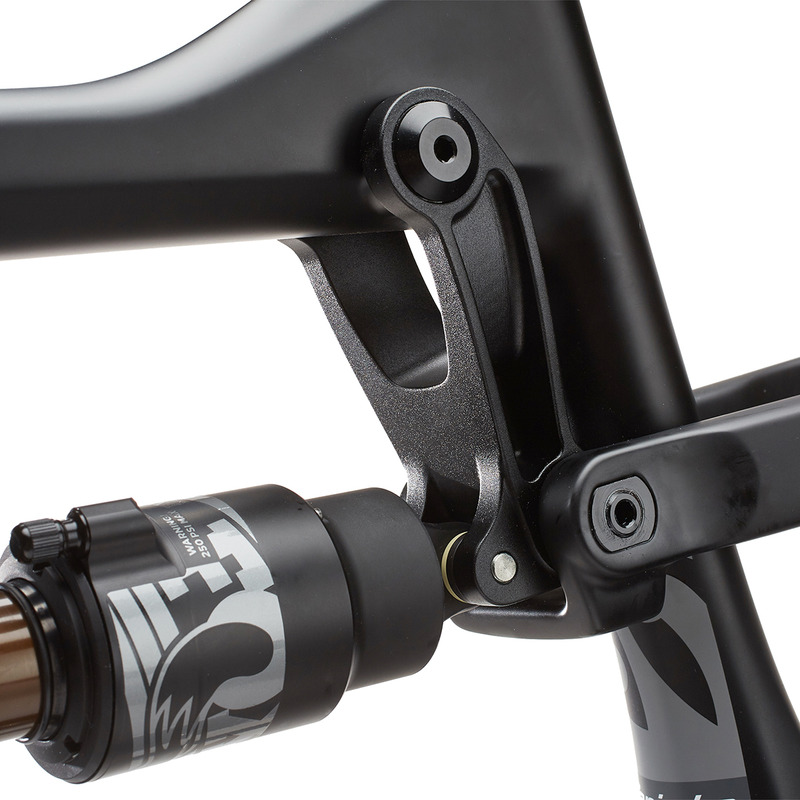 Zerode Taniwha X2 Shock Mount Detail
Zerode Taniwha X2 Shock Mount Detail
Building the Zerode Taniwha was trouble free. It went together easily and we just had to watch the cable install video on the Pinion Website a few times to get that running smooth. The i9 305mm Enduro wheels are strong trail wheels. These are a bit stronger than was probably required and we could have laced up some lighter custom wheels and saved some weight. We opted to build the bike with almost the exact same build that we used on our Evil Insurgent Review. Overall our complete Zerode Taniwha came in at 34.85LBS and we are running WTB Convict/Trail Boss front in rear both in TCS casings. So these are about 1.5 lbs heavier than a Maxxis set-up would be. So, in theory, you could build one close to this at the low 33lbs range. Just an FYI our XL Insurgent weighed mid 32LBS with a very close build so about 2.25 lbs lighter in a frame size bigger than the Taniwha we tested.
"Fundamentally the Zerode Taniwha is about making the mountain biking experience better. Nothing inspires us to ride more than a quiet, low maintenance, confidence inspiring bike
The 12 spd pinion gearbox offers a huge spread of gears that goes well beyond today’s 1×11. Whether you are grinding up an epic backcountry single track or blasting down a high speed fire-road there is a gear to do the job. An unexpected pinch climb will never be a problem again, changing gear is effortless and immediate.
A significant reduction in unsprung weight ensures suspension performance that is undeniably better than any Enduro bike equipped with a rear derailleur. Symmetrical spoke angle ensures a very strong, light rear wheel that further improves suspension performance.
A simple, effective and proven suspension platform combined with a fixed chain line optimizes pedaling performance through the entire travel range. It is difficult to approach the elegance and performance of this layout with any virtual pivot design.A sleek full carbon frame offers excellent stiffness, reduced weight and flawless beauty in a modern geometry.
Maintenance and tuning of gears are almost nonexistent, sprocket and chain life are massively extended. On a Zerode, that brand new drivetrain feeling happens every day.
For those that ride for fun, the Zerode Taniwha will inspire you to ride in any conditions on any trail. If you are racing, whether it for an EWS podium or for bragging-rights amongst mates, the Taniwha provides an edge your competition won’t have.”
 Zerode Taniwha Pro Build Complete Zerode Taniwha Pro Build
Zerode Taniwha Pro Build Complete Zerode Taniwha Pro Build
- Zerode Taniwha Large Frame Fox X2
- Fox 36 Rc2 Fork
- Chris King Inset
- Gamut Cillos Stem
- Enve DH Bars
- Hope Tech 3 E4 Brakes 203/183
- Industry Nine 305 Enduro Wheels
- Fox Transfer 150mm Dropper
- WTB Convict TCS-WTB Trail Boss TCS
- Fabric Saddle
- ESI Grips
Zerode Taniwha Geometry
I took the Taniwha out on a trail that climbs about 700 feet in just over 1 mile and I could tell The Zerode had a 4 lbs weight gain over the Django I tested earlier. It's pedaling ability was good even with the X2 shock in open mode. For about 85% of the time while climbing we used the pedal feature on the X2. But you could tell it had more weight compared to the last bike I was on. It also offers a bit more traction on the climbs as well.
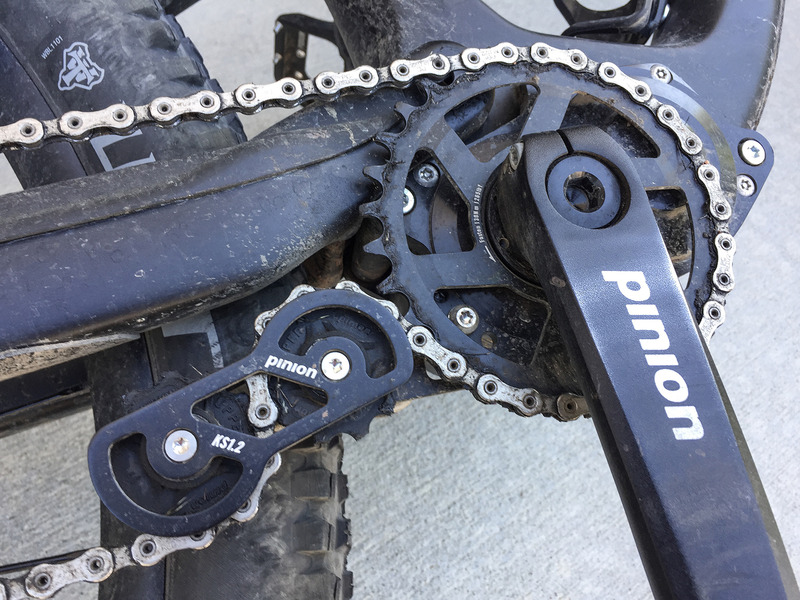 Taniwha Pinion Tensioner Detail
Taniwha Pinion Tensioner Detail
Once at the top I strapped on my bell and goggles and got ready to drop in. The first part is high speed and fire road width with a good scattering of rocks. I could tell right away The Taniwha was more forgiving when hitting bigger rocks than the previous test bike. It didn't have the roll over ability as the Evil Wreckoning but the 29" wheels gave that bike a large edge. The suspension on the Zerode did smooth the entire trail out better though.
 Zerode Taniwha-Pinion Mounting
Zerode Taniwha-Pinion Mounting
The trail takes a hard left through rocks and enters a very high speed off camber single track section. there are some large rocks here you dodge and weave your way through. After that, it goes right back across the mountain through some ruts and up and over a steep roller that acts as a G-out and typically uses most of a bikes suspension when hitting it at speed.
Zerode Taniwha Pronouced TANIFA
This trail is somewhat smooth compared to others in the area. Also towards the end, you have to climb up some twisty single track to finish it off. this is where we used the ability to shift without pedalling in the very tight turns and come out in a gear that was easy enough to climb with. Overall the trail was a little too mellow for The Taniwha. You could tell it wanted something much rowdier to show off its unhindered suspension.
Taniwha Pinion Cable Routing
About 300 feet up from the first trail is one that is rock filled for about 500 yards and enters a fast twisty section of trail for the last mile or so. This is a good trail to get a feel for how a suspension system will perform. The entrance to this trail you can hit pretty high speeds my best ever was 28mph and I was just under that aboard The Taniwha. The bike felt stable going fast and there are rocks scattered all across this double track section of trail. It seemed to offer good traction and felt very planted in the high-speed quick turns in this section.
There is a small climb up that takes you to the rocky part of the trail. You enter this on a fading right-hand turn that drops you into the rock garden. The rocks range in size from marble up to knee high here. The fastest route is a straight line down the middle and linking the sections together by hopping over and down the larger embedded rocks. Overall I would say the suspension worked remarkably well. The trail felt smoother than it did on many of the other trail bikes we have tested. Maybe saving the weight off the back wheel does translate into better trail manners after all. This trail has some loose turns and the Zerode Taniwha seemed to offer a fair bit of traction. It wasn't as much as a 29" bike but more than a normal 650B seemed to offer. This also can be attributed to the suspension sensitivity and the low center of gravity. There are a number of fast turns back to back in this trail that you can hop the bike into and hope it grabs traction. The low center of gravity really seemed to help the bike find grip easier here than many of the other 650b bikes we have tested. Moving around on the Taniwha to effect front end traction or lift the front wheel was very easy. The window of balance on the bike was huge. Keep in mind this frame is a fair bit shorter than the last two bikes we have tested so this feeling can directly be attributed to the gearbox being down low on the frame. The Zerode proved to have a stiff frame. I never noticed The Taniwha showing any kinds of flex in tight turns or even high-speed rock filled ones.
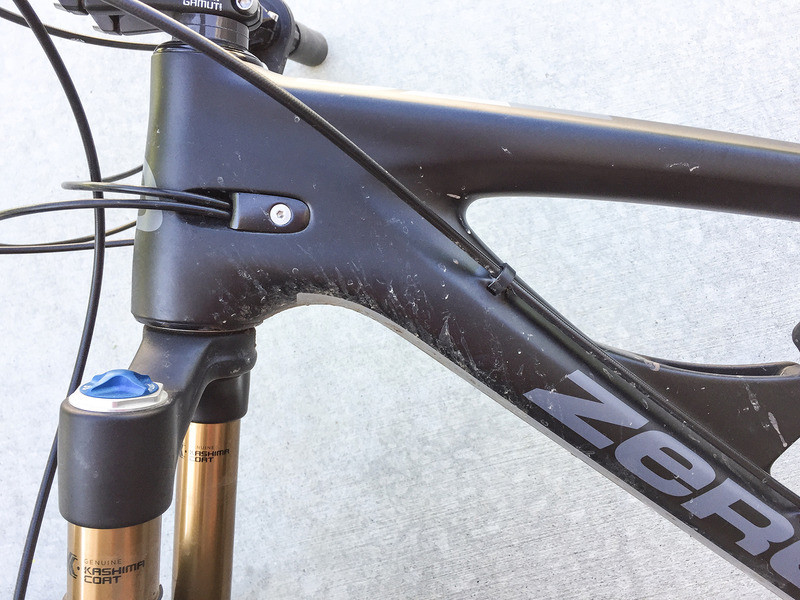 Zerode Taniwha Internal Routing
Zerode Taniwha Internal Routing
So the Zerode Taniwha descends well in part due to having a very light rear end and one of the lowest centers of gravity around. Also, the simple suspension design works very well at eating rough terrain and is one of the easiest to set up. But how does the Taniwha climb or pedal? Let us get this out of the way now. You can tell it has a gearbox when pedaling on the flat ground. It makes a bit more noise than a standard bike with a full chain guide. It isn't as loud as the old school Mr. Dirt guide but it makes noise just a slight whirring from between your feet. Pinion claims the gearbox gets smoother as you rack up the miles. We put about 500 miles on the bike and would have to agree with them. It did begin to make less noise and seem to offer a bit less resistance. Honestly, if there is a bit a drag while riding the Zerode Taniwha it is very mild. In fact, it may entirely be in my head. Getting to the trails from work is about a 2-mile flat pavement pound. I never made it there as fast as I have on a few other bikes. Now shifting the Zerode takes a bit of forethought at the beginning. The Pinion will not shift into an easier gear under load. When I say load I mean like the weight of you leg will prevent it from shifting. So essentially you have to stop pedaling the Taniwha to get it to shift. On the steep technical climbs make sure to shift when you can and not when you need to since it may not be possible. Another thing that was noticeable was the lack of engagement provided by the Pinion. We had i9 wheels with 120 points of engagement and it still had some play. This was really obvious when you back pedal and then try to pedal forward. The gearbox would take about 30 degrees of rotation before it engaged. It would be interesting to see what an Onyx hub would feel like. Using a Pinion adds about 2 lbs to The Zerode Taniwha and there is no great way to cut that weight back. As stated earlier we had an Insurgent with the exact same build in size XL and this Taniwha is a LG frame and still, the complete bike is about 2.2-2.4 lbs heavier. The new C-Line Pinion will shave about 250 grams off the bike so you will have a 1.75lbs penalty. Is the added weight and shifting issue worth it to avoid a derailleur? This is all dependant upon you, where you live, what you ride and how lazy you are on servicing equipment.
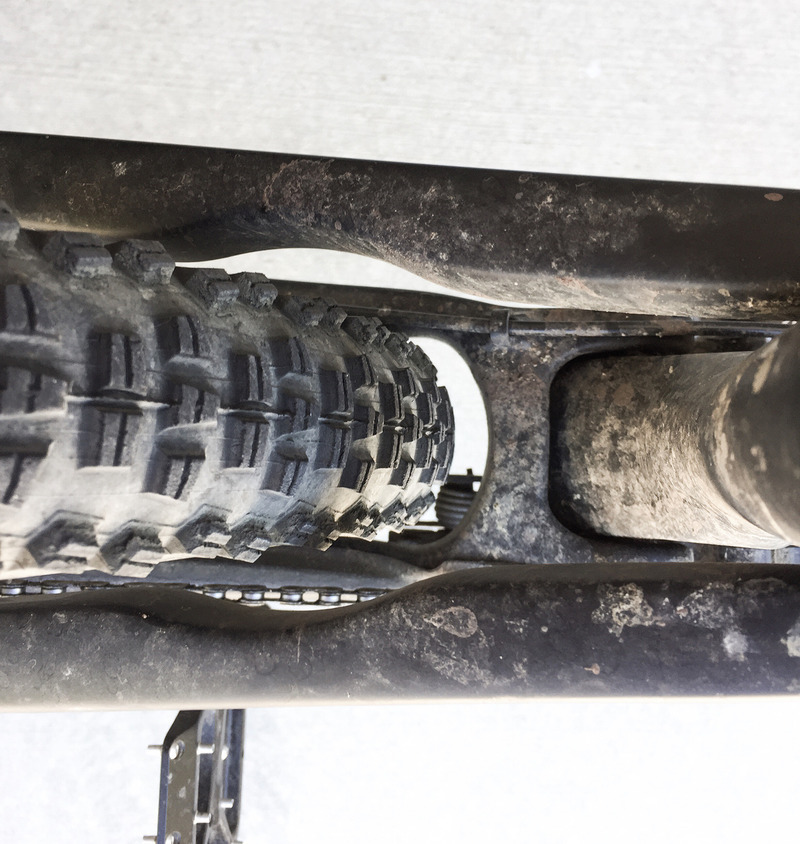 Zerode Taniwha Rear Chainstay Clearance.
Zerode Taniwha Rear Chainstay Clearance.
There are some areas to improve and this will all depend on Pinion and what they can do with the box in the near future. The "Grip Shift" on the Taniwha was a non-issue it took a few rides to become accustomed to the wrist twisting mode to shift gears. I have had a few SRAM Grip Shift bikes back in the day so I have some experience with it. There is no issue of a missed shift or of an accidental one for that matter. MX bikes ride terrain four times as rough at speeds that are much faster and having a twist throttle is a non-issue for them so why would a twist gear shift be an issue for a MTB? What needs mentioning here is the insane range that The Pinion P 12 gearbox offers. It is just over a 600% range and Rob from Zerode equates it to having a 10-60 on the rear of a standard bike! Another good thing is that every gear change provides the same ratio jump you will never shift a gear and make a dramatic change like you can with a normal 11-12spd system. If you require a different gearing setup for your Zerode you can do it but you must use the Pinion front and rear sprocket to do so. They offer a few teeth in either direction from the ones specked on the Taniwha. I would venture to say that most riders will almost never use the two top easiest gears. They are so tall that to keep a walking pace you are spinning fairly fast on the cranks! Speaking of range the ability to dump a large number of gears with the twist of a wrist is something that can become a great benefit for those that ride in terrain with large elevation changes or tighter trails. Keep in mind you can all this without having to move the cranks!
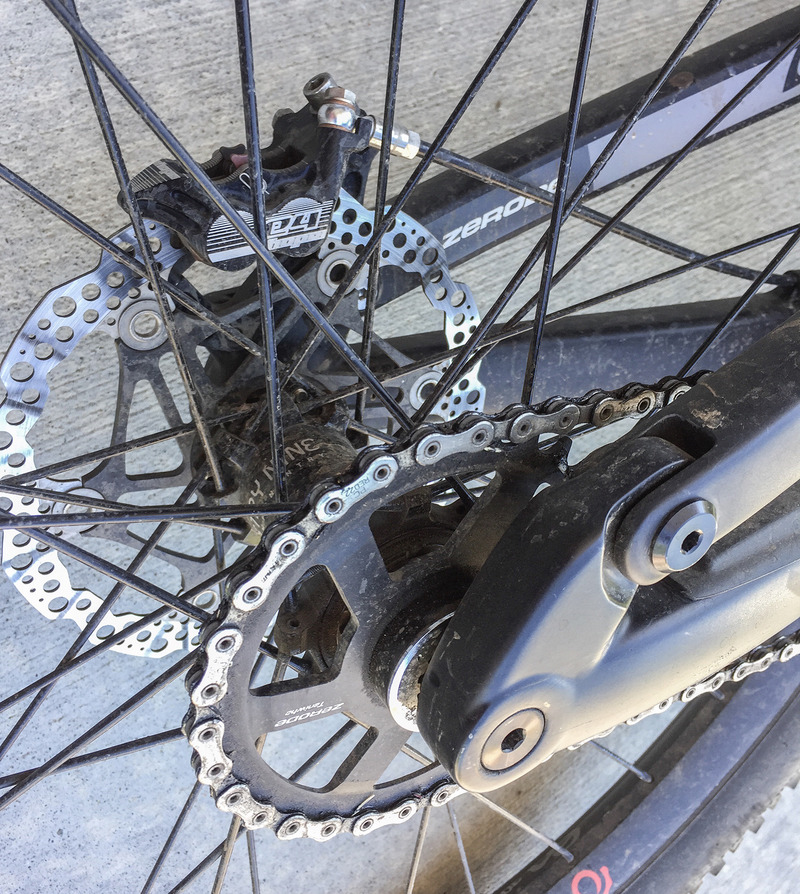 Zerode Taniwha Chainstay DetailConclusion
Zerode Taniwha Chainstay DetailConclusion
Overall we liked The Taniwha. It has a straightforward suspension design that a marketing crew doesn't need to spend millions of dollars on to convince the general public that it works. It pedals pretty well even with the X2 wide open and very little LSC on the shock. I think running the shock with a bit more LSC would have allowed us to rarely use pedal mode on the Fox shock. Even though it shares a similar suspension system with a Guerilla Gravity Megatrail it doesn't have as much resistance to pedal bob as that bike seems to. We had a CCDB Air on that so that could be the difference.
The Pinion gearbox on the Zerode moves weight off the back wheel and centers it as low as possible on the BB. This gives The Taniwha a distinct advantage over a traditional derailleur system in the suspension department. Saving almost two pounds off the back wheel makes the suspension much more active at slower speeds. Another thing that is unique to The Taniwha is it's fixed chain line that optimizes pedaling performance. It gives the bike a unique feel on the pedals and in theory is better. Going up and over rocky terrain, the bike feels like it rolls over terrain easily even when applying power. The range The Pinion offers on the Taniwha is huge and having the ability to jump between all those gears without even pedalling is pretty nice. Cornering is something I mentioned earlier and the Taniwha excels at this. This is a weak point in my riding and the Zerode provided tons of traction and a very wide body weight window. I have the tendency to weight the front too much at times and this never happened once while riding this bike. It feels as if the Zerode grants the rider and extra foot of room to make body adjustments while riding. Also worth mentioning is removing the most easily damaged item off the back wheel and eliminating it. For many, this is an issue but in all honesty, over the past 30 years of riding, I have broken about 8 derailleurs and 6 of those where during a decade of downhill racing.
So with the positives gained from running a Pinion gearbox on the Zerode Taniwha, there are also negatives. There is no denying that the Pinion adds 2.5 lbs over a traditional system and even the new C-Line version will add 2 lbs to the bike. Along with that comes its low engagement this wasn't a make or break but sometimes it was noticeable. Also not being able to shift under load is our main issue with it. It took us awhile to get somewhat used to letting up while climbing especially on steeper terrain. Everyone gets fried out and has to shift into an easier gear at one point or another during a climb. Typically I could just dump a gear and keep going. With the Taniwha I would have to stop pedaling all together to get the bike into an easier gear. Keep in mind that Pinion hasn't been around very long and with their background in automotive engineering, I would only assume that they would get their gearboxes able to shift under load at some point. The grip shift is a nonissue for us but some have complained about it in the past once Zerode said they were going to use a Pinion. There are rumors of a trigger shifter being in the works from Pinion currently. So that may change as well.
Basically, it will come down to the consumer and their needs or desires. Do you want the most efficient suspension over rough terrain or the most efficient pedaling machine? Mountain bike designs are a compromise. You give up suspension performance in favor of pedaling performance. In the case of the Zerode we gain some weight and lose out on shifting into an easier gear under load. While you gain a very active suspension attached to a frame that corners like it's on rails due to it having a very low center of gravity. Another benefit of The Zerode Taniwha will be lower maintenance and a chain that will last seasons instead of months. With a rear cassette costing close to $300 these days, it will save you money by not replacing one of those every 6 months. In theory, the gearbox proponents are correct, you can break off a derailleur it's just a question of how often that may happen to you.
Overall the Zerode was a fun bike to ride. It was very active and ate up all trail nuances with ease. Frame stiffness was very good and it cornered better than most other trail bikes we have tested. People looking for a unique bike that will prove to be low maintenance should take a good hard look at The Zerode Taniwha. We would recommend this to a friend looking for a unique "stick it to the man" do it all bike that could spend the day at the park or a day riding the local trails. Go check out Zerodeusa for more information on the Taniwha. If they only made it in 29" wheels....
Zerode Taniwha Pinion Set Up
Zerode Taniwha FAQ's
Is Grip shift the only option?
It turns out that the grip shift is a very nice match to a drive train when you do not have to pedal to change gear and the gears change instantly. If you get caught out in the wrong gear on a pinch climb you can back off for a split second and rip through a bunch of gears with a twist while the derailleur guys are trying to pedal over the top of the wrong gear or click and crunch through gears one at a time. There is no comparison in this situation. You can grab gears when coasting, back pedalling so you adapt and change when and where you shift, the grip shift lets you do this in a seamless way. I have no doubt a trigger will be available at some point. I have designed one on paper, friends have made their own but I'm not sure experienced pinion users will want to swap the grip for a trigger.
Why no horst link?
In a nut shell. I don't link them. The pedalling performance of a Taniwha is second to none. The "real" pivot design combined with a fixed chain line means it is possible to achieve very stable pedalling through the entire range of suspension travel while independently control the suspension rate via a link. With a Horst link or VVP design the virtual pivot races all over the show making it hard to control suspension rate and pedalling independently. You get a compromised design but one that marketing departments love…
Brake jack?
There is a huge amount of misinformation online about brake effect. The story goes, "single pivot designs suffer from brake Jack or brake lock out". In reality all bikes, even bikes equipped with horst links have brake effect to some degree. What happens is the traction force at the rear tire tends to rotate the suspension about the pivot whether real or virtual causing a suspension compression. It's worth noting the traction force at the rear wheel is usually small and so is the compressive effect and that the suspension is still free to respond to other inputs. Some bikes have more compression than others, in some situations this compression helps performance, in other situations it hinders performance.
I could go into an in depth analysis of brake effect. However, there is no need, motorcycles have used simple swingarm designs for over a century now, motorcycle designers fully understand brake effect and understand that a simple swingarm design is the best solution. Almost every DH world champ since records began had a bike with a brake effect essentially the same as that of a single pivot bike.
Gearbox range?
Imagine a 10-60 cassette. Enough said.
Gearbox drag?
Obviously there is an extra element in the drive train so there has to be losses. The loss is small and depends on load and gear. A comparison with a clean mech with a chain in the middle of the cassette would obviously have a standard mech come out on top. If you take into account a significant reduction in unsprung weight changing gears instantaneously and the fact the a mech drive trains efficiency falls off quickly when the chain is at the top or bottom on the cassette or when sprockets are small, then add a little bit of dirt or mud the Pinion becomes very attractive. I wouldn't use one on a road bike but a 160mm trail/enduro bike for riding proper mountain bike trails it is a no brainer .
Why a gearbox/what about the weight?
If you add a Pinion gearbox, take away a cassette (unsprung weight), derailleur( unspring weight), chain guide and build a lighter stronger rear wheel and the disadvantage is ~800g. Given that you have to power yourself and the bike up hills and overcome rolling and air resistance the extra effort required when climbing is almost not measureable. Even if it was I would happily breathe a little harder while cruising up the hills with my mates if my reward was a significant improvement in suspension performance, 600% gear range, stronger rear wheel, almost no maintenance, chains that last years, shifting without pedalling, instantaneous shifting, no chain slap, optimised pedalling etc etc I'd be very surprised if Taniwha owners go back to a derailleur.
Zerode Taniwha Grade Card
 EWS,
EWS,  Enduro,
Enduro,  Gearbox Bke,
Gearbox Bke,  Pinion,
Pinion,  Taniwha,
Taniwha,  Taniwha Gearbox,
Taniwha Gearbox,  Zerode,
Zerode,  Zerode Gearbox,
Zerode Gearbox,  Zerode Taniwha Test,
Zerode Taniwha Test,  Zerode USA,
Zerode USA,  Zerode taniwha |
Zerode taniwha |





